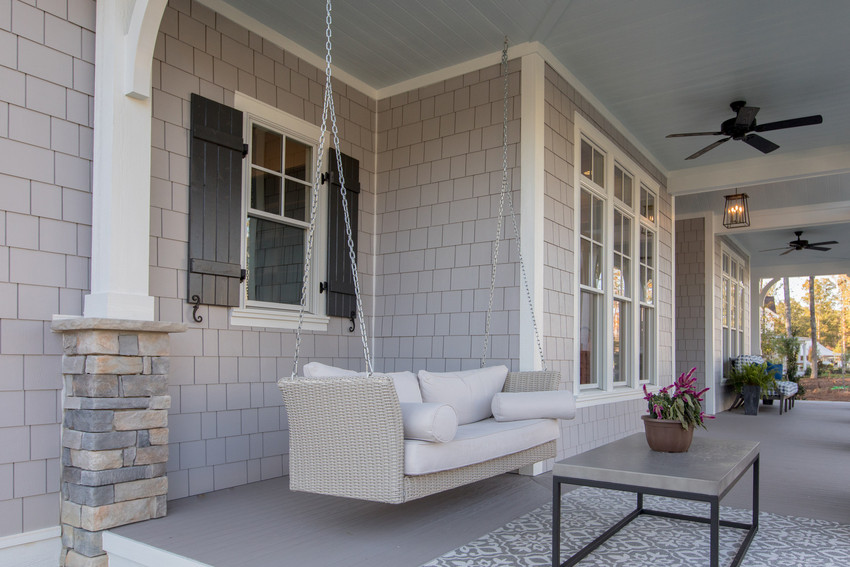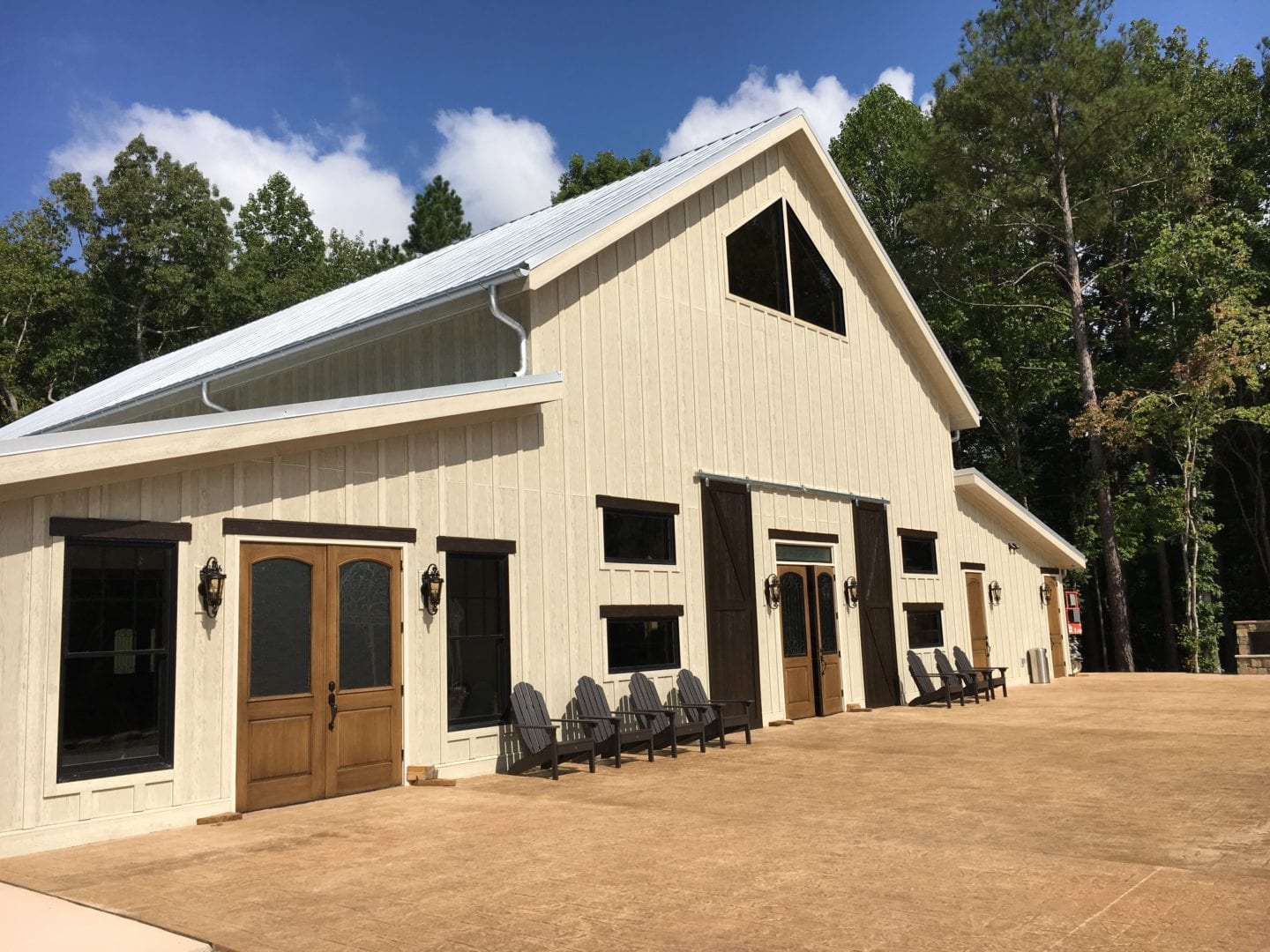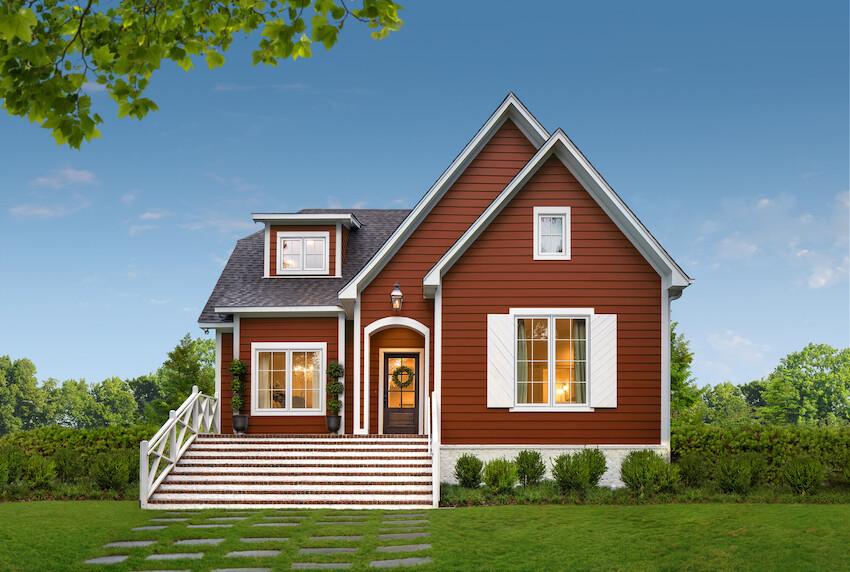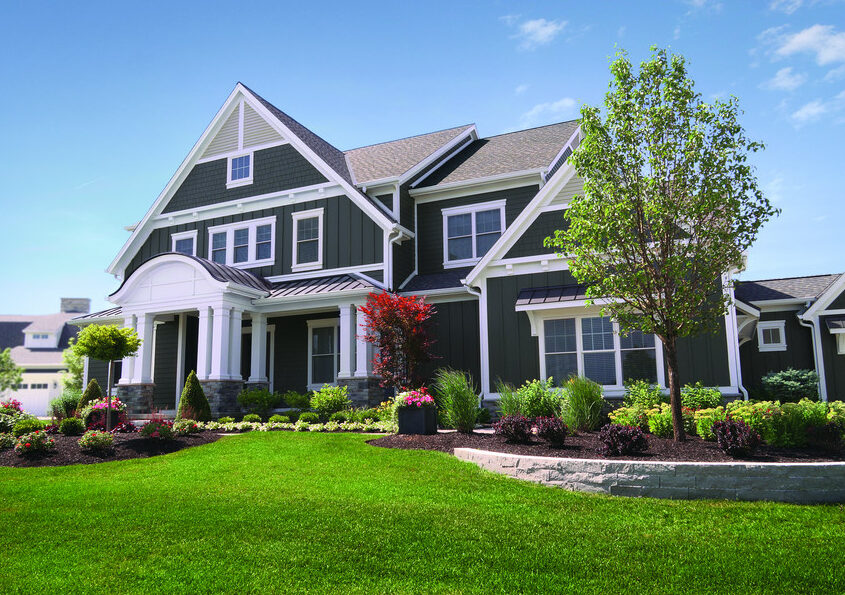We may earn revenue from the products available on this page and participate in affiliate programs. Learn More ›
While it’s been around for years, there are several reasons that fiber cement siding is becoming more and more popular with homeowners: Some appreciate the sustainable aspects of its production. Others favor the material for its architectural appeal. Fiber cement’s minimal maintenance costs are yet another reason for its popularity. While professional installation is recommended, fiber cement siding can last for decades once it’s on your home. The product’s longevity, more than anything, may explain the high demand for the material.
When compared to other types of siding for the home, fiber cement siding offers significant advantages. Some of the biggest reasons homeowners choose cement board siding over vinyl or other alternatives are:
- Fiber cement siding holds paint well, so it requires less frequent repainting.
- The siding is available in a variety of styles, including lap, panel, and shingle.
- Cement fiber board siding is also available in baked-on, prefinished colors that don’t require painting.
- Fiber cement siding is super durable. It won’t dent as steel siding can, and won’t crack the way vinyl siding can.
What You Need to Know About Fiber Cement Siding
Not all fiber cement siding is the same, and there are different aspects about the category of siding that can affect which product is right for a home in a particular climate.
Fiber Cement Siding Maintenance and Longevity
Fiber cement siding composition may vary from company to company, but the basic recipe is Portland cement, sand, and cellulose (wood) fibers. Wood fiber helps prevent cracking, as does a unique curing process that leaves fiber cement board with minimal moisture content.
Each of the major manufacturers offers a line of cement fiber siding that meets or exceeds standards set forth by the American Society for Testing and Materials. The siding stands up, not only to the elements but also to hazards like insects and noise pollution. Repainting is necessary after 10 to 15 years, but maintenance duties are light otherwise. Indeed, manufacturers’ warranties attest to the product’s durability, with 30- to 50-year warranties being the norm.
Fiber cement siding has the durability of cement, a class 1A fire rating, is impervious to wood-boring insects, does not rot, and is resistant to deterioration from salt and ultraviolet rays. “The added cost of fiber cement is made up by the fact that once it’s up, you don’t have to worry about it,” says Lisa Santerian, marketing director for CertainTeed WeatherBoards fiber cement siding.
Fiber cement offers low-maintenance siding. It’s impact-resistant, closely mimics natural siding material such as wood, and it’s available in primed or painted options. Most companies warranty their product for 50 years, which speaks well of its durability.
Styles of Fiber Cement Siding
When fiber cement siding first came on the market in the early 1990s, only a handful of styles were available, most of which were 6-inch planks and board-and-batten type panels. In the following decades, manufacturers broadened their offerings to include a wider variety of styles and widths. Today, homeowners can find virtually any type of siding in a fiber cement product, making it simple to match most types of existing siding, even those on historic homes.
Shapes and Sizes

The fiber cement siding industry has spent years perfecting the look and finish of its product. This type of exterior siding comes in a variety of designs: lap, plank, vertical, shake, curved-shake, and geometric patterns are all available.
Color and Finish
Fiber cement siding comes in a host of textures and finishes, and it can be tinted to virtually any hue the homeowner desires. Some fiber cement siding products resemble wood, while others simulate the look of natural fieldstone, stacked flagstone, or brick. Surface designs are created during manufacturing ,when the surface is either embossed or left smooth.
For homeowners who prefer to paint their siding a custom color rather than selecting one of the manufacturer’s hues, pre-primed fiber cement siding is a terrific option. It can be painted with any quality exterior paint. The cement ingredient in the siding is porous, just as concrete is, which helps lock the pigment in place.
Shingles, Clapboards, and Trim
In addition to shingles and planks, fiber cement is available in every imaginable siding style, including clapboards and wood-look shakes. “We can do any sort of architectural shapes and styling, and the consumer can pick any color they want,” says Santerian. “You can even get half-rounds and octagon shapes if you want.”
To complete the look, manufacturers such James Hardie, maker of the popular HardieZone siding system, offer matching soffit, fascia, and trim. To achieve the best results (and adhere to the brand’s warranty stipulations), HardiePlank, generically known as “Hardieboard” or “Hardie board siding,” should be paired with molding and trim from the same manufacturer and the same siding line.
The Cost of Fiber Cement Siding
The upfront expenses associated with fiber cement siding are considerable, being that most homeowners opt to have the product professionally installed. The good news is that the siding’s ongoing maintenance costs are minimal. You’ll incur the expense of repainting about every 10–15 years or so, but the lion’s share of the overall cost will come at the beginning of the product’s 50-plus-year lifespan.
Fiber cement siding’s material costs alone ranges from about $0.70 to $15 per square foot, but installation costs are additional and depend on the going rate of labor in the community. Professionally installed fiber cement siding ranges from around $5 to $25 per square foot.
Should You DIY Fiber Cement Siding Installation, or Hire a Pro?
A homeowner who has a working knowledge of construction practices can often install fiber cement siding without any problems. It’s more challenging than vinyl siding to install because it requires some special tools for cutting, and like any DIY project, care must be taken when measuring, cutting, and making sure the siding is perfectly level.
Fiber cement is heavier than vinyl siding and aluminum siding, but it is lighter weight than natural wood or stone, which means it is not terribly difficult to install. Installation guidelines should be closely followed, particularly when it comes to cutting the product and keeping it dry.
Cutting fiber cement is more challenging than cutting natural wood; it requires pneumatic or handheld shears, a dust-reducing circular saw, or a diamond-tip miter saw. Cutting fiber cement will release silica dust into the air, so be sure to wear a mask when cutting. In addition, a DIYer probably needs to invest in heavy-duty saws that will withstand the task of repeatedly cutting through cement siding panels.
DIYers and contractors alike should follow handling and storage recommendations. Saturated or moist fiber cement siding can shrink at the butt ends if installed before drying. “All our packaging states very clearly: ‘Do Not Install Wet Product,” Santerian says. “Unfortunately, we still hear tales of installers spraying the product down before installation.” Proper storage of the product before installation is essential if the siding is to stay dry. A sheltered storage space is best.
Fiber Cement Siding: A Greener Alternative
There are many reasons why homeowners choose fiber cement siding for their homes, and one of the most important is that it’s a more sustainable option to many other types of siding. As a wood alternative—but not an engineered wood—fiber cement has forest-saving properties and environmentally friendly qualities. For example, CertainTeed takes the wood fiber needed for its fiber cement siding from sustainably managed forests. Other manufacturers use only recycled wood, which also helps reduce tree harvesting.
Some fiber cement siding manufacturers also use fly ash (a byproduct of coal-burning) to replace the sand and silica, thereby adding post-industrial recycling to its list of attributes. Fly ash also makes the fiber cement lighter than its sand and silica counterparts, making it easier to handle and install.
James Hardie, the founder of fiber cement and world leader in the siding category, is equally committed to sustainability—sourcing 90 percent of its materials from regional suppliers and employing waste minimization and solid waste recycling technologies to support “zero waste to landfill” initiatives. While cement, water, sand, and cellulose fibers are used for James Hardie siding products, fly ash is not. The company believes that it adversely impacts the durability of fiber cement.
Even though individual manufacturers have their own formulas and preferences, fiber cement siding is generally free of any volatile organic chemicals (VOCs) and toxic compounds that are unsafe to breathe and can result in headaches, nausea, and respiratory symptoms. This makes fiber cement production healthier for the environment than siding made from vinyl, a synthetic product that creates VOCs during the manufacturing process.
Comparing Fiber Cement to Other Types of Siding

Fiber cement siding is an alternative to natural wood, stone, stucco, brick, aluminum, and vinyl siding options. On average, for a 1,500 square-foot house, homeowners can expect to pay between $27,000 and $30,000 to have fiber cement installed.
Although fiber cement has endured some largely unwarranted criticism concerning moisture issues following faulty installation, it remains one of the more durable siding products in the industry.
Fiber Cement Siding vs. Wood
Wood siding boasts a timeless beauty, and many homeowners value the way its appearance gradually changes in subtle ways. You can save on installation by doing the work yourself, but wood siding products demand a high level of maintenance. Still, if your priority is good looks, then you can’t go wrong with wood.
The cost to have wood siding installed is generally lower than that of fiber cement siding, ranging from about $10,000 to $13,000 for a 1,500 square-foot house. A significant upside to wood siding is that homeowners can replace just a small section of with new siding and have it blend in seamlessly.
Fiber Cement Siding vs. Brick and Stone
Brick and stone are considered premium types of exterior siding because they add a level of structural integrity to a home’s walls while providing a measure of insulation and protection against the elements. They’re also the most expensive siding types, ranging from $45,000 to $52,000 on average to clad a 1,500-square-foot house.
Unless the homeowner is experienced in masonry, installing brick or stone is not a DIY project. Because these materials are heavy and require the installation of a brick ledge to support them, excavation and concrete work will also be necessary if the home doesn’t already have an existing brick ledge.
Fiber Cement Siding vs. Vinyl
If budget is the primary concern when shopping for new home siding, vinyl is a competitive alternative. Like fiber cement siding, vinyl siding can be a DIY project as long as the DIYer has a working knowledge of construction practices. When vinyl siding is professionally installed, a homeowner can expect to pay between $18,000 to $21,000 to side a 1,500-square-foot house.
Though most modern products are colorfast and resistant to insects and rot, vinyl siding is not maintenance free. Its vulnerability to weather damage makes occasional repairs necessary. Still, the price tag is competitive and appeals to many homeowners.
Fiber Cement Siding vs. Aluminum
Aluminum siding today is more affordable than other types of siding, ranging from around $7,700 to over $11,000 to have a 1,500-square-foot house professionally sided.
Aluminum siding is lightweight, installation is DIY-friendly, and the product resists rot, fire, and insect infestations. The downside to aluminum siding is its propensity to dent on impact. An intense hailstorm can leave the whole side of a house with noticeable pits that can’t be removed. Though it was once a common siding choice for many homeowners, aluminum’s popularity is fading given the better and more durable siding options available today.
Fiber Cement Siding vs. Stucco
Another type of exterior finishing, stucco is a premium product and it comes with a high price point. At $42,000 to $45,000 to have a 1,500-square-foot house professionally finished, stucco is in the same price range as brick and stone. In regions where stucco isn’t commonly used, it can cost even more to install.
Stucco is often used on southwestern and Tuscan-style homes. While professionals may make its installation look easy, stuccoing a house is anything but a DIY project. In order to achieve a strong stucco exterior, the product must be put on in layers, with the semi-solid compound smoothed over metal lath for stability.
Best Brands of Fiber Cement Siding

Today, multiple brands of fiber cement siding are available, but some have become household names in the construction industry.
James Hardie
James Hardie was the first company to manufacture fiber cement siding, and the company continues to produce a wide range of siding and trim products. In addition, James Hardie offers HardieZone siding, which is made with different climates in mind. HardieZone products contain different amounts of cement and other components to suit specific weather situations better than others.
GAF
While the company’s name is General Aniline & Film, it just goes by GAF these days, and it produces a wide range of construction products in North America. Its fiber cement siding line is available in local lumberyards or from The Home Depot, and it offers a range of trim and accessories in addition to basic siding styles.
American Fiber Cement Corporation
Another major manufacturer of fiber cement siding, the American Fiber Cement Corporation offers a variety of siding styles and accessories. The siding products come with a choice of either visible attachments or concealed attachments. The latter provides a seamless look. Don’t plan on looking into this siding for your house, however—it’s typically only available for large commercial projects, such as strip malls and industrial buildings.
Woodtone
A smaller, but up-and-coming manufacturer, Woodtone offers a range of construction materials and fiber cement siding is one of them. Woodtone specializes in producing siding that looks like natural wood. Its RusticSeries lap siding is available in a wide range of colors, and trim pieces are also available.
Allura
Elementia, a division of the Mexican Consortium, now produces the fiber cement siding previously manufactured by CertainTeed. The siding now sells under the Allura or Allura Plycem name and is widely available throughout North America. The product is offered in planks, panels, trim, soffit, shake singles and more, and can be purchased from local lumberyards or larger home improvement centers, such as Menards.
Final Thoughts

For great looks and durability at approximately half the cost of brick or stone, fiber cement siding is a top option. While it requires heavy-duty tools to cut and install, it’s still among the more DIY-friendly siding options. The product comes pre-painted in non-fading colors or can be painted to suit. Plus, it’s low-maintenance.
Some of the most popular brands of fiber cement siding mimic the look of natural wood so closely that casual observers are unlikely to know the difference. But, unlike real wood, which requires cutting down trees, fiber cement siding products won’t add to global deforestation, which makes the product a more eco-friendly alternative.
FAQs
Fiber cement siding comes with some of the most extended guarantees in the industry, typically around 50 years, so it’s among the longest-lasting siding products. It will need occasional repainting, however, usually every 10 to 15 years or so, depending on the quality of the paint.
While costs can vary based on region, it can run an average of $27,000 and $30,000 to have a 1,500-square-foot home professionally sided. Material costs range from $0.70 to $15 per square foot, depending on the product.
Typically, fiber cement siding needs to be painted every 10 to 15 years.
When fiber cement siding cracks, it’s often due to structural settling of the house. Cement is a component in concrete, so think of the siding as “concrete siding.” It’s tough and can withstand impacts such as large hail, but if the home’s foundation shifts, fiber cement siding can crack.
Hardie board is a generic term for James Hardie fiber cement siding. The term has become so common, it’s often casually used for other brands of concrete board siding as well.


